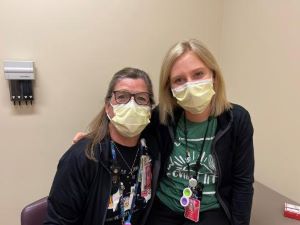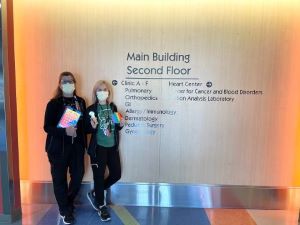Did you know Phoenix Children’s received a grant from Panda Express to expand our Child Life services to outpatient clinics on the Thomas campus? In October 2021, a team of child life specialists began to provide child life services to clinics in the main building, Rosenberg building, and Ambulatory building. Each day, these child life specialists visit with children and families who come to Phoenix Children’s for a variety of specialty care services.

We know visiting a hospital can be stressful for anyone, but it is especially stressful for children who may not understand their health concerns and treatment plan. Child life specialists are skilled at preparing patients for medical procedures at a level the child understands. Child life specialists also provide developmentally appropriate coping skills for children and encourage long-term support by empowering family members to help children during uncomfortable medical procedures.
Today we are following child life specialists, Suzanne Berner and Kylee Smith, on the second-floor outpatient clinics in the main building. Suzanne and Kylee work as a team to cover several clinics including pulmonology, orthopedics, gastrointestinal & hepatology, surgery, allergy & immunology, dermatology, gynecology, and the Heart Center. Suzanne and Kylee’s day typically begins reviewing requests for child life support. Nurses, medical assistants, doctors, patients, and families can request a visit by a child life specialist. Child life specialists are often consulted for children who are anxious when visiting the doctor, and for children who may be scheduled for an uncomfortable or invasive procedure. In addition, child life specialists can work with families prior to an appointment if their child has special needs and would benefit from having child life specialist support during their child’s appointment.

Once Suzanne and Kylee review all requests for child life services, they divide the requests and plan their day. For example, Suzanne may take the three visits in the allergy & immunology clinic and Kylee may take the four visits in the orthopedic clinic. When the patient arrives, the child life specialist tries to meet the patient upon arrival to the clinic appointment, so they can talk about what to expect for the upcoming appointment.
For example, today Kylee is meeting 5-year-old Andres who is scheduled for a cast removal on his wrist. Kylee has learned from Andres’ medical record that he has had a cast on for four weeks, is fearful of medical staff, and loves dinosaurs. Andres meets Kylee when he enters the cast room. In her pocket, Kylee has a few sensory toys ready, including a dinosaur shaped pop-it, and a hand-held massager that gently vibrates and can be used to help children know what a cast saw feels like. Kylee explains the cast removal procedure to Andres: “The cast tech will use a machine that vibrates to take off the cast. It is noisy and shakes back and forth. Some kids even think it tickles.” By describing what he will see, feel, and hear, Andres’ fears about the cast saw can be reduced, and Andres has a better understanding of the procedure. Andres decides to sit on his mother's lap and is offered headphones to block the noise of the machine. Andres plays with the pop-it and chooses to watch his favorite show on a tablet. Andres is distracted by the pop-it toy and tablet and able to hold still for the cast removal. By providing choices, such as sitting with mom, using headphones, and watching a favorite show, Andres can feel a sense of control during the procedure. After Andres’ cast is removed, he waits to talk with his doctor about how his wrist is healing.
Then, Kylee is off to see the next patient!
